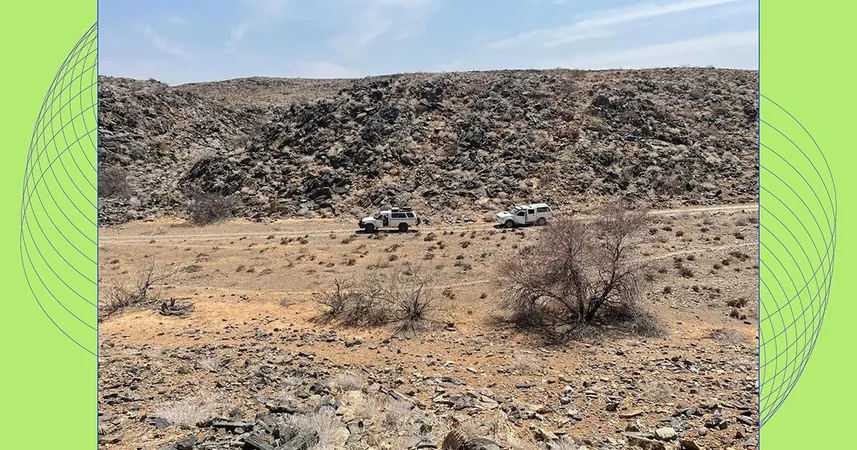
Revolutionary Discoveries: Is Venus's Crust Churning with Hidden Volcanoes?
2025-04-01
Author: Wei
Venus, the second planet from the Sun, has long been shrouded in mystery, filled with dense clouds and dominated by extensive volcanic features. Recent groundbreaking research from scientists at Washington University in St. Louis unveils the possibility that Venus's crust is far more dynamically active than previously thought. The research suggests that a phenomenon known as convection could be occurring within the planet's outer layer, igniting discussions about its volcanic landscape's evolution.
According to Professor Slava Solomatov, a leading expert in earth, environmental, and planetary sciences at WashU, "No one had really considered the possibility of convection in the crust of Venus before." The study indicates that such convection might not just be possible—it could be a common occurrence. This revelation opens up exciting pathways for understanding the geological processes shaping our sister planet.
Published in the journal Physics of Earth and Planetary Interiors, the study showcases the insights of postdoctoral researcher Chhavi Jain and utilizes sophisticated fluid dynamic models. These models were designed to evaluate whether the unique thermal and structural conditions on Venus could support convective activity—a mechanism typically linked with Earth’s mantle.
Convection on Earth is a process where warmer materials ascend while cooler materials descend, fostering a cycle that drives tectonic actions. Venus, with its crust potentially measuring between 30 to 90 kilometers in thickness and enduring extreme temperatures up to 870 degrees Fahrenheit, may possess the ideal conditions for such movement. This could reveal why Venus is riddled with countless volcanoes, a mystery that has captivated scientists for decades.
Significantly, previous research indicated that Mercury, due to its smaller size and prolonged cooling history, lacks such convective capabilities. In stark contrast, Venus remains a seething world of heat, likely facilitating the aforementioned crustal movements.
The implications of these findings are tremendous. Convective activity in the crust could provide crucial insights into the distribution and formation of the numerous volcanoes on the planet’s surface. In a comprehensive study released in 2023, WashU's Paul Byrne mapped an astounding 85,000 volcanoes on Venus using radar data from NASA’s Magellan mission. Insights from this current research could lead to collaborations combining theoretical models with advanced surface imaging techniques to decode the complex geological narrative of Venus.
Looking to the future, the potential for upcoming space missions is huge. These missions could measure variations in the crust's density and temperature, potentially identifying differences in gravity that would confirm the existence of convection within the crust.
Moreover, the exploration of convection isn’t limited to Venus. Professor Solomatov draws parallels with Pluto, where NASA's New Horizons missions provided revealing images of Sputnik Planitia, suggesting tectonic-like convection in solid nitrogen ice. "Pluto is probably only the second planetary body in the solar system, other than Earth, where convection that drives tectonics is clearly visible on the surface," he stated, underscoring the exciting research still ahead.
As scientists continue to unravel the mysteries of Venus and other celestial bodies, we may just be on the brink of a new understanding of geological processes not only on our own planet but throughout the solar system. Can Venus's hidden convective activity explain its volcanic frenzy? Only time and further exploration will tell! Stay tuned for more revelations that could change our understanding of planetary geology!

 Brasil (PT)
Brasil (PT)
 Canada (EN)
Canada (EN)
 Chile (ES)
Chile (ES)
 Česko (CS)
Česko (CS)
 대한민국 (KO)
대한민국 (KO)
 España (ES)
España (ES)
 France (FR)
France (FR)
 Hong Kong (EN)
Hong Kong (EN)
 Italia (IT)
Italia (IT)
 日本 (JA)
日本 (JA)
 Magyarország (HU)
Magyarország (HU)
 Norge (NO)
Norge (NO)
 Polska (PL)
Polska (PL)
 Schweiz (DE)
Schweiz (DE)
 Singapore (EN)
Singapore (EN)
 Sverige (SV)
Sverige (SV)
 Suomi (FI)
Suomi (FI)
 Türkiye (TR)
Türkiye (TR)
 الإمارات العربية المتحدة (AR)
الإمارات العربية المتحدة (AR)